Introduction
The MIMO technology has been a part of the evolution of wireless communication. MIMO has set its imprint in wireless networks. As this technology advanced, Massive MIMO was introduced, revolutionizing wireless networks, particularly in 5G technology. By significantly increasing the number of 5G antennas at the base station, Massive MIMO enhances the capacity and efficiency of 5G architecture, making it an essential factor for the exponential growth of data traffic and the proliferation of connected devices.
Let’s understand MIMO technology in detail.
What is MIMO?
MIMO full form is Multiple Input, Multiple Output. It is an antenna technology used in wireless communications. The MIMO technology uses multiple MIMO antennas (RF transmitters and receivers) to optimize data transmission speed. It improves the capacity of radio transmissions by enabling data to travel over many signal paths and spatial paths simultaneously.
When a packet is transmitted and received through multiple MIMO antennas, it creates multiple versions of the same signal, increasing the opportunities for the data to reach the receiving antenna without being affected by fading. This results in a higher signal-to-noise ratio and a lower error rate, leading to a more stable connection and reduced congestion.
MIMO technology is crucial for enhancing the capacity of various systems like RF systems, Wi-Fi networks, 4G LTE antennas, and 5G antenna networks. For example, Wi-Fi is an example of a WLAN network, which uses wireless radio technology (long-range Wi-Fi antennas) to connect PCs, phones, and other devices in a limited space. It helps in boosting the system capacity of WLANs (Wireless Local-Area-Networks). Wi-Fi works on the IEEE 802.11 standards and relies on APs (wireless access points) to connect devices using 2.4 GHz, 5 GHz, and 6 GHz frequencies.

Types of MIMO in Wireless Communication
There are two types of MIMO
- Single-User MIMO (SU-MIMO)
- Multi-User MIMO (MU-MIMO)

What is Single-User MIMO (SU-MIMO)?
In Single-User MIMO configuration, the access points (APs) transmit data to one client at a time. Each client is served sequentially, which means that a lower-speed client can slow down the overall downlink throughput for other clients on the network as well. SU-MIMO focuses on enhancing the connection between the AP and a single device, improving its performance without considering multiple devices at the same time.
What is Multi-User MIMO (MU-MIMO)?
MU-MIMO allows the access point to send multiple data packets to multiple clients over the same frequency simultaneously. This significantly increases airtime efficiency regardless of the 802.11 version used. MU-MIMO works by dividing network resources spatially and transmitting them simultaneously through multiple 5G antennas. This approach significantly improves the data transmission efficiency of a network without occupying extra spectrum resources.
MU-MIMO works in conjunction with beamforming technology, where an MU-MIMO AP measures the characteristics of channels from each antenna to each terminal and performs precoding calculations on the data to be transmitted. This ensures that each terminal receives only the data intended for it, similar to forming directional beams to each terminal.
MU-MIMO can be classified into downlink MU-MIMO (DL MU-MIMO) and uplink MU-MIMO (UL MU-MIMO) based on the transmission direction. DL MU-MIMO enables an AP to send data to multiple terminals simultaneously, while UL MU-MIMO allows an AP to receive data from multiple terminals simultaneously.
It leverages the concept of multiple antennas on both the access point (router) and the devices transmit and receive data simultaneously.The DL MU-MIMO and UL MU-MIMO are used in Wi-Fi networks with multiple devices. DL MU-MIMO was introduced in Wi-Fi 5 (802.11ac Wave 2) while UL MU-MIMO was introduced in Wi-Fi 6( 802.11ax). They help in enhancing user experience by minimizing waiting time of data transfer, speeding up upload and download process.
What is Massive MIMO?
Massive MIMO (Multiple Input Multiple Output) is a sophisticated form of MIMO technology extensively employed in both 5G NR (5G New Radio) and 5G RedCap (5G Reduced Capability) technologies. This approach involves deploying a substantial number of network antennas at the base station—a stark contrast to traditional MIMO systems, which typically feature only a few antennas. Massive MIMO systems are characterized by their use of hundreds, or even thousands, of antennas, enabling them to manage complex, high-density communication scenarios effectively.
The core principle of Massive MIMO lies in using this extensive array of antennas to create multiple spatial channels between the base station and the users. This setup allows Massive MIMO to handle the simultaneous transmission and reception of multiple data streams. Consequently, Massive MIMO significantly enhances the spectral efficiency, capacity, and reliability of the communication link, making it a cornerstone of modern 5G networks. By leveraging the capabilities of Massive MIMO, network operators can ensure robust and efficient service delivery even in areas with high user density, thereby maximizing the performance benefits of 5G technology.
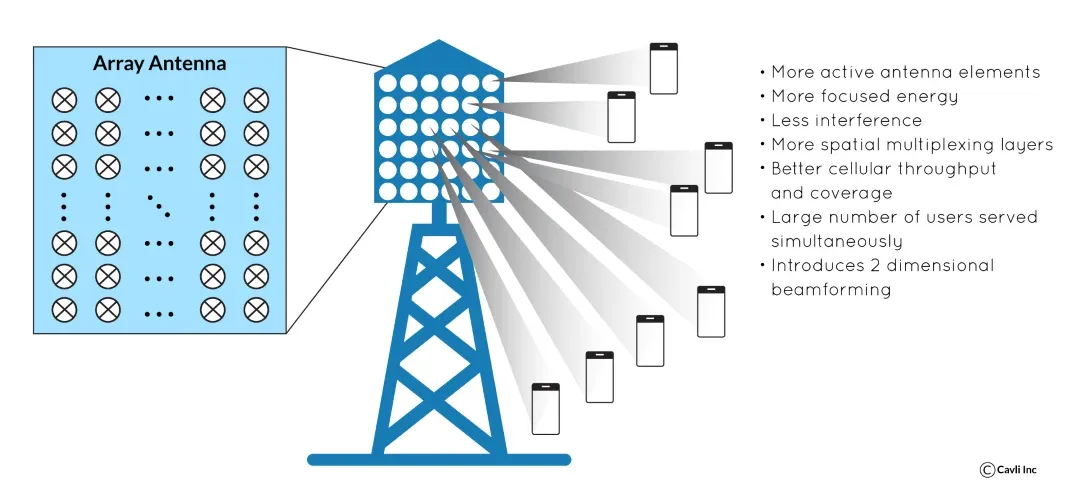
MIMO Techniques Used in Cellular Networks
Spatial Diversity
Spatial diversity is a technique used in wireless communication devices to improve the quality and reliability of a signal. It employs multiple antennas with the same characteristics but physically separated from one another. This separation helps to mitigate the effects of signal fading, which can occur when the signal travels over multiple paths and arrives at the Wi-Fi receiver with different strengths and phases.
A signal encounter with obstacles such as buildings, trees, or mountains causes signal fading, which can even cause complete signal loss. Spatial diversity helps to overcome this problem by using multiple antennas to receive the signal.
Each antenna receives a slightly different version of the signal due to the different paths taken by the signal. By merging these different versions, it improves the overall signal quality and reduces the impact of signal fading.
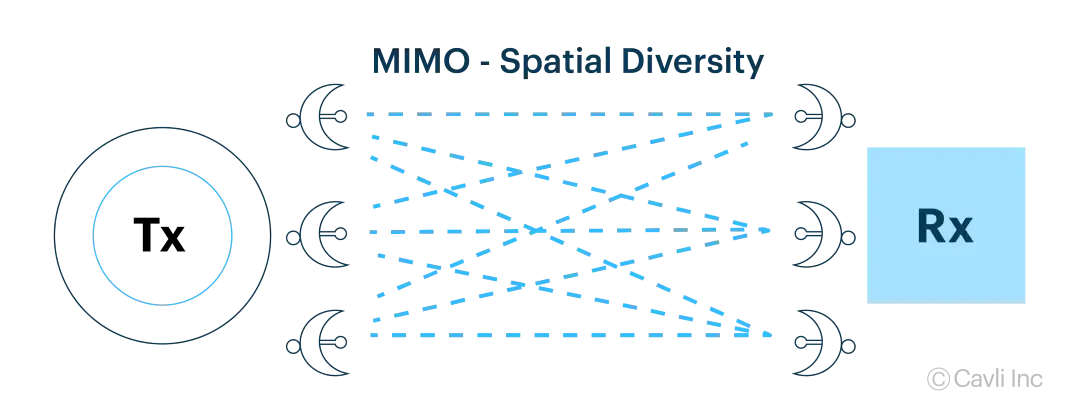
Spatial Multiplexing
Spatial multiplexing in 5G, also known as space-division multiplexing (SDM), is a technique used in various communication systems, including wireless communication and fiber-optic communication, to increase data transmission capacity. It leverages the spatial domain by transmitting multiple independent data streams simultaneously through multiple antennas.
Spatial multiplexing is primarily a part of Wi-Fi communication. It involves sending multiple spatial streams through multiple Wi-Fi antennas, which are then separated at the Wi-Fi receiver through spatial processing. The Wi-Fi receiver decodes the transmitted streams individually, allowing for increased data throughput for a fixed channel bandwidth. While spatial multiplexing boosts spectral efficiency, it does not provide diversity gain.
Combining OFDM (Orthogonal Frequency Division Multiplexing) in MIMO wireless communication devices leads to increased spectral efficiency as the spatial multiplexing antenna gain offered by MIMO is used in combination with multi-carrier modulation. This combination also enhances connection stability and provides a high quality of service.
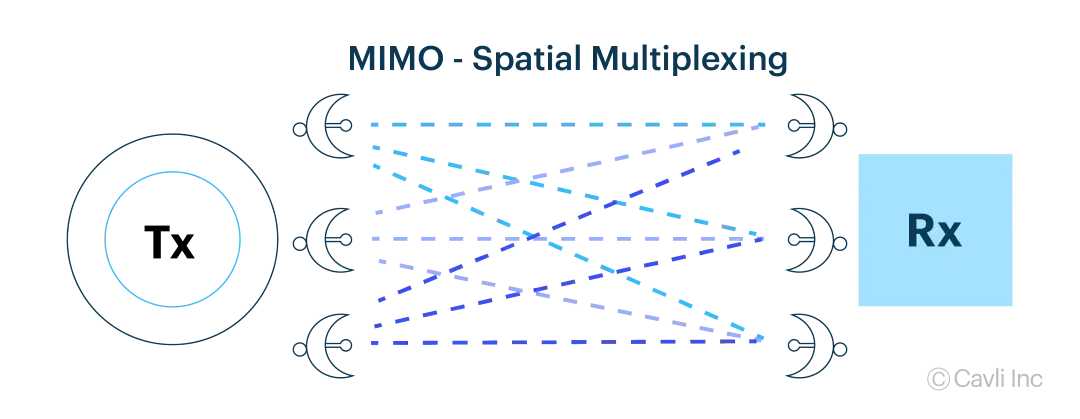
Beamforming
This technique focuses a signal in a particular direction to achieve the greatest possible gain at the receiving end. Beamforming can be analog (performed with a phased array), digital (using precoding with modulated data streams to construct a beam pattern), or hybrid (a combination of analog and digital, multiplexed spatially/temporally). Different 5G beamforming methods require different signal processing methodologies to precode and decode signals.
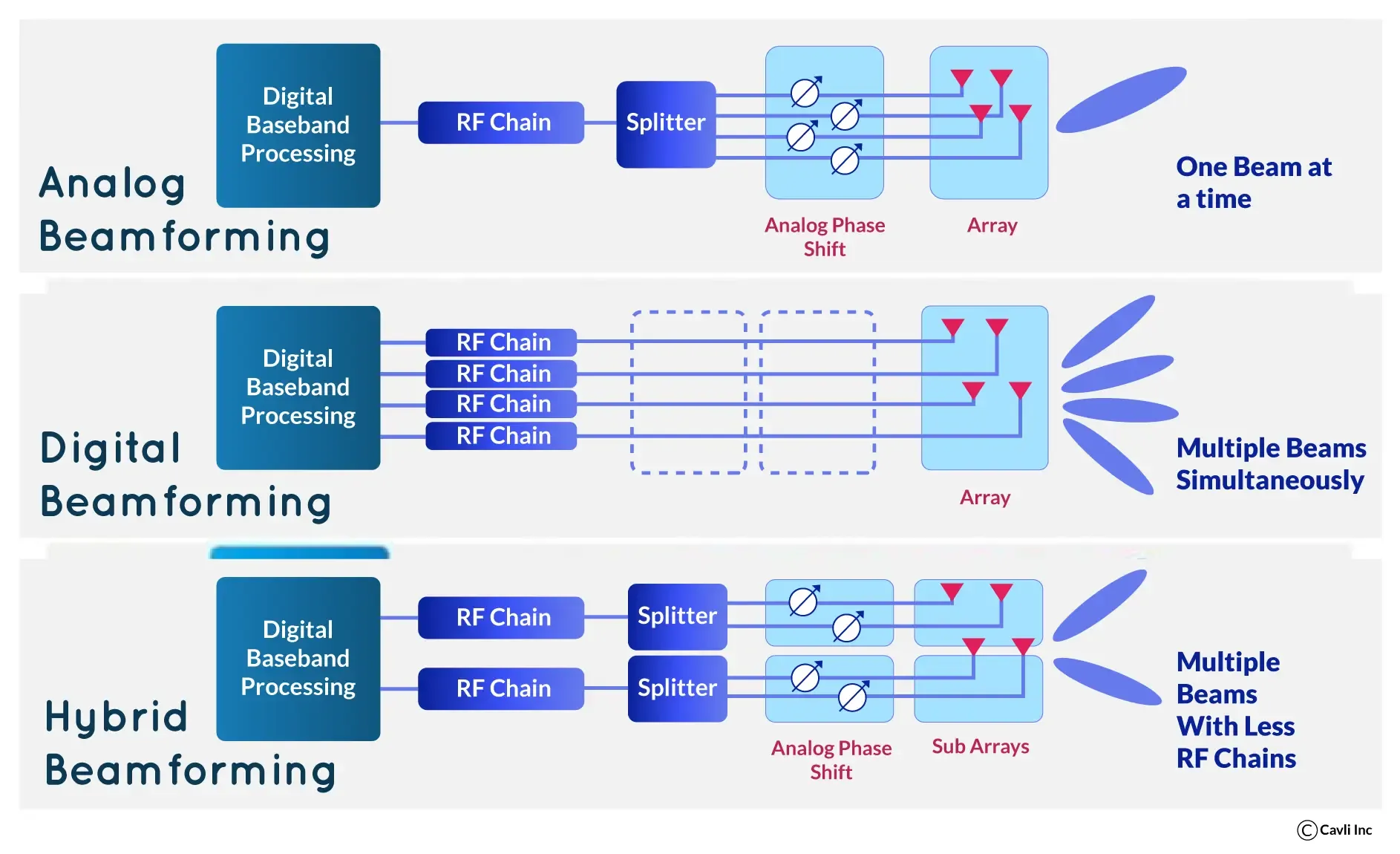
Precoding
Precoding is a signal processing technique in wireless communication devices to enhance performance and mitigate interference. It involves coding the transmitted signals before they are sent out, aiming to optimize the received signals at the receiver's end. It complements beamforming. Precoding focuses on signal processing at the transmitter, while beamforming occurs at the receiving end and directs signals toward the receiver. It maximizes the signal-to-noise ratio (SNR), minimizes interference, and ultimately improves the overall quality and reliability of data transmission.
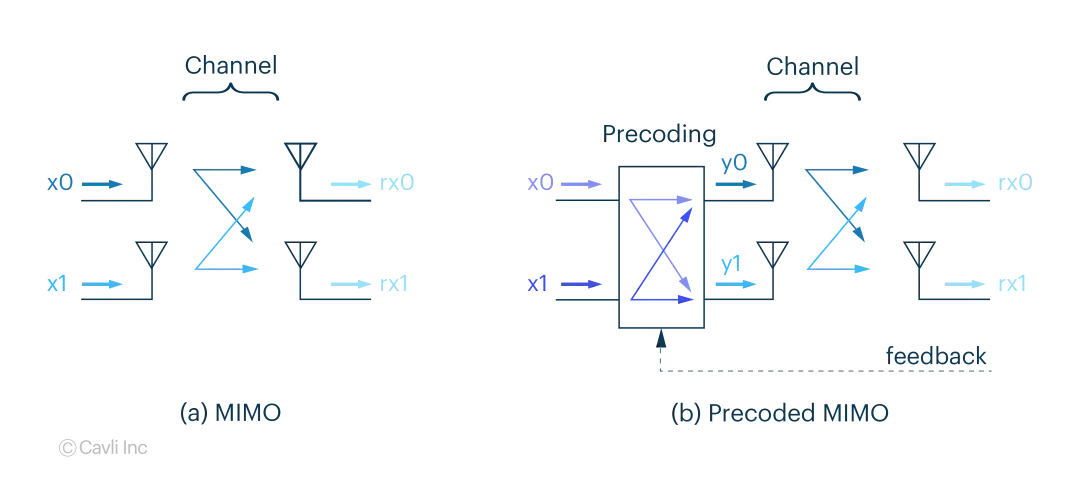
Advantages of Massive MIMO in 5G Technology
Increased Spectral Efficiency
Massive MIMO significantly improves spectral efficiency, allowing more bits to be transmitted in the same amount of spectrum. This is crucial for meeting the high data rate demands of modern wireless networks.
Enhanced Network Capacity
By using a large number of antennas, Massive MIMO can serve many users simultaneously, greatly increasing the network's capacity. This is particularly beneficial in densely populated areas where many users are competing for network resources.
Optimized Energy Consumption
Despite the use of many antennas, Massive MIMO can be more energy-efficient than traditional systems. By focusing energy directly where it is needed, the system can reduce overall power consumption.
Extended Coverage
Massive MIMO can extend the coverage area of base stations, providing better service to users at the edge of the cell and reducing dead zones within the network.
MIMO Antenna Applications
Mobile Communications
MIMO antenna technology significantly enhances mobile communication networks by boosting signal strength and reducing interference, thus improving call quality and data transmission speeds.
Wireless Broadband
MIMO antennas are vital in providing stable and fast wireless broadband services. This is particularly crucial in densely populated urban areas where high data throughput and network reliability are essential.
Satellite Communications
In satellite communications, MIMO technology helps in achieving higher data rates and more reliable connections between satellites and ground stations, even in adverse weather conditions.
Wi-Fi Networks
MIMO technology is used in Wi-Fi routers and devices to increase the range and speed of wireless networking within homes and businesses, allowing for faster streaming, gaming, and internet browsing.
Radar Systems
MIMO antennas are employed in radar systems for automotive and aviation applications, enhancing the detection and tracking capabilities of objects by using multiple antennas to send and receive signals.
IoT Devices
In the Internet of Things (IoT), MIMO antennas help manage the communication between a vast number of devices, ensuring efficient data transmission and reception across complex networks.
Closing Notes
MIMO, especially Massive MIMO in 5G technology, is a cornerstone technology for 5G networks due to its ability to meet the high speed, low latency, and massive connectivity requirements of 5G. It enables the network to handle exponentially more data and users simultaneously, which is essential for supporting emerging technologies and IoT applications such as virtual reality, and autonomous vehicles. Additionally, Massive MIMO's enhanced capacity and coverage make it ideal for delivering consistent, high-quality mobile experiences to users, which is a key goal of 5G networks. Leveraging the advantages of Massive MIMO, 5G networks can provide the next wave of technological innovation and IoT connectivity.
Visit us to know more about Cellular LPWA and cellular IoT connectivity modules.
Amusing Tech Chronicles
Facts and Anecdotes Related to this Edition of Wireless By Design

Garden Watering System
Imagine watering a garden with just one hose; you can only water one area at a time. Now imagine a watering system with multiple hoses (MIMO system) watering several parts of the garden at the same time. Similarly, MIMO sends and receives multiple data streams simultaneously, improving throughput and efficiency.

The Orchestra
In an orchestra, multiple instruments (antennas) play together to create a full-bodied sound (data signal). Each instrument adds its own tone and depth, creating a more sophisticated music piece than if only one instrument were playing. Similarly, MIMO combines signals from multiple antennas to create a more robust and detailed data transmission.

Packaging and Sorting Facility
Imagine a facility where packages are sorted and dispatched. If there's only one conveyor belt (single input/output), the process can be slow. However, if the facility uses multiple belts (like MIMO), it will speed up the process. This analogy helps us understand how MIMO increases the capacity and speed of data transmission.
Go Beyond and Explore
What does 4x4 MIMO and 2x2 MIMO mean?
4x4 MIMO and 2x2 MIMO refer to the number of antennas used for transmitting and receiving data in a Multiple-Input and Multiple-Output (MIMO) system. The first number (e.g., 4 or 2) represents the number of transmit antennas used to send data signals. The second number (e.g., 4 or 2) represents the number of receiver antennas used to receive data signals. MIMO technology is used in various wireless communication systems, such as MU-MIMO routers, Wi-Fi router antennas, and cellular networks to improve data transmission speed and reliability.
How many antennas are there in 5G Massive MIMO?
There's no strictly defined maximum for antenna configuration in massive MIMO, the technology thrives on utilizing a large number of Wi-Fi antenna elements at the base station compared to traditional MIMO systems. Commercially deployed massive MIMO systems typically use configurations in the range of 64x64. Researchers have explored and successfully tested configurations exceeding this, reaching up to 256x256 elements.
How does MIMO work in Wi-Fi routers?
MIMO uses multiple Wi-Fi router antennas on routers and devices to transmit and receive data simultaneously. This boosts Wi-Fi speed, range, and reliability by overcoming signal interference and combining different data streams. The latest Wi-Fi 6 utilizes MIMO technology by focusing on Multi-User MIMO (MU-MIMO Wi-Fi) with a smaller number of antennas (typically up to 8) and improved efficiency.

